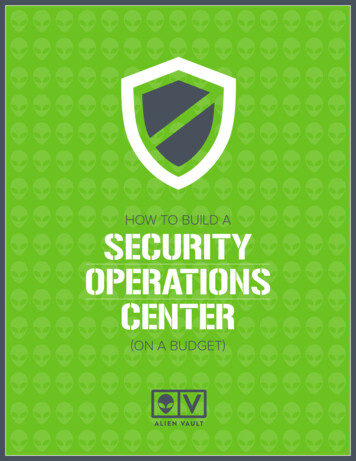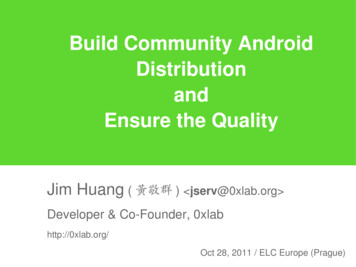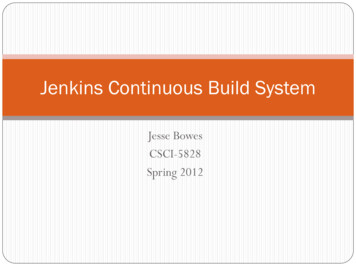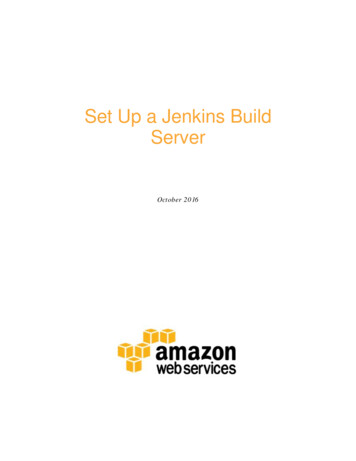
Transcription
HOW TO BUILD ASECURITYOPERATIONSCENTER(ON A BUDGET)
IntroductionSOC BASICSWhether you’re protecting a bank or the local grocery store, certaincommon sense security rules apply. At the very least, you need locks onentrances and exits, cash registers and vaults as well as cameraspointed at these places and others throughout the facility.The same goes for your network. Controlling access with tools likepasswords, ACLs, firewall rules and others aren’t quite good enough.You still have to constantly monitor that these security controlscontinue to work across all of your devices, so that you can spotstrange activity that may indicate a possible exposure.The tools you use to do security monitoringand analysis may be a bit more varied than just aCCTV monitor, but the concept is the same.Unfortunately, unlike with CCTV cameras, you can’t just look into a monitorand immediately see an active threat unfold, or use a video recording toprosecute a criminal after catching them in the act on tape.The “bread crumbs” of cyber security incidents and exposures are farmore varied, distributed and hidden than what can be captured in a singlecamera feed, and that’s why it takes more than just a single toolto effectively monitor your environment.1alienvault.com
ISecurity Ops101Building an SOC:SOC teams are responsible for monitoring, detecting,containing and remediating IT threats across applications,devices, systems, networks, and locations.Using a variety of technologies and processes, SOC teams relyon the latest threat intelligence (e.g. indicators, artifacts, and otherevidence) to determine whether an active threat is occurring,the scope of the impact, as well as the appropriate remediation.Security operations center roles & responsibilities have continued toevolve as the frequency and severity of incidents continue to increase.BUILDING A SOC WITH LIMITED RESOURCESIN A RACE AGAINST TIMEFor many organizations (unless you work for a large bank), building a SOC mayseem like an impossible task. With limited resources (time, staff, and budget), settingup an operations center supported by multiple monitoring technologies and realtime threat updates doesn’t seem all that DIY. In fact, you may doubt that you’ll haveenough full-time and skilled team members to implement and manage these differenttools on an ongoing basis. That’s why it’s essential to look for ways to simplify andunify security monitoring to optimize your SOC processes and team.Thankfully, AlienVault provides the foundation you need to build a SOC - withoutrequiring costly implementation services or large teams to manage it. With AlienVaultUSM , AlienVault Labs Threat Intelligence, and AlienVault OTX , you’ll achieve a wellorchestrated combination of people, processes, tools and threat intelligence.All the key ingredients for building a SOC.In each chapter of this eBook, we’ll go into detail on each of these essentialcharacteristics.2alienvault.com
Chapter 1PEOPLEThe Security Operations Center (SOC) Team: Review key Security OperationsCenter Roles and Responsibilities for building a SOC team. Examine our SOCSkillset Matrix to assist with recruiting and staffing a strong SOC team.Chapter 2PROCESSESEstablish the key processes you’ll need to build a security operations center.These include Event Classification & Triage; Prioritization & Analysis; Remediation &Recovery and Assessment & Audit. Examine how AlienVault USM, AlienVault Labs,and AlienVault OTX support these critical processes.Chapter 3TOOLSReview the essential security monitoring tools you’ll need for building a SOCincluding: Asset Discovery, Vulnerability Assessment, Intrusion Detection,Behavioral Monitoring and SIEM / Security Analytics. Explore the real-worldbenefits of consolidating these tools into a single platform like AlienVault USM.Chapter 4INTELLIGENCEUnderstand the differences among Tactical, Strategic & Operational Intelligenceand the specific ways these are used within the SOC. Examine the benefits ofcombining crowdsourced and proprietary data sources and explore key aspectsof AlienVault OTX and AlienVault Labs Threat Intelligence.Chapter 5REAL WORLDBuilding a SOC in the Real World. Examine real-world use cases whereAlienVault’s technologies, communities, and threat intelligence provide theperfect SOC set-up.3alienvault.com
Chapter 1PEOPLEJust like people, every security organization is different. In somecompanies, the executive team has realized the significance of cybersecurity to the business bottom line. In these cases, the SOC team is ina great position: enough budget for good tools and enough staff tomanage them, and the “human” capital of executive visibility and support.But that’s not the reality in most cases, unfortunately.SOC teams are fighting fire with never enough staff, never enoughtime, and never enough visibility or certainty about what’s going on.That’s why it’s essential to focus on consolidating your toolset,and effectively organizing your team.A SOC team that has the right skills, using the least amount of resources all while gaining visibility into active and emerging threats. That’s our goal.So how do we get there?Let’s talk about the key security operations center rolesand responsibilities you need to support a SOC.Key Takeaways Review key Security Operations Center Roles and Responsibilities for building aSOC team. Examine our SOC Skillset Matrix to assist with recruiting and staffing a strong SOC team.alienvault.com4
Setting up the SOC FoundationTHE QUICK BASICSThere are two critical functions in building a SOC.The first is setting up your security monitoring tools to receive rawsecurity-relevant data (e.g. login/logoff events, persistent outbound datatransfers, firewall allows/denies, etc.). This includes making sure yourcritical servers and security devices (firewall, database server, file server,domain controller, DNS, email, web, active directory, etc.) are all sendingtheir logs to your log management, log analytics, or SIEM tool.(We’ll go into more detail about how USM provides this criticalcapability as well as others like IDS in the next chapter).The second function is to use these tools to find suspicious ormalicious activity - analyzing alerts, investigating indicatorsof compromise (IOCs like file hashes, IP addresses, domains, etc.),reviewing and editing event correlation rules, performing triageon these alerts by determining their criticality, scope of impact,evaluating attribution and adversary details, as well as sharing yourfindings with the threat intelligence community etc.Knowing what it will take for building a SOC will help you determine howto staff your team. In most cases, for security operations teamsof 4-5 people, the chart on the next page will relay our recommendations.5alienvault.com
ROLEDESCRIPTIONRESPONSIBILITIESTriage Specialist(Separating the wheatfrom the chaff)Sysadmin skills (Linux/Mac/Windows); Programmingskills (Python, Ruby, PHP, C,C#, Java, Perl, and more);Security skills (CISSP, GCIAGCIH, GCFA, GCFE, etc.)Reviews the latest alerts to determinerelevancy and urgency. Creates newtrouble tickets for alerts that signalan incident and require Tier 2 / IncidentResponse review. Runs vulnerabilityscans and reviews vulnerabilityassessment reports. Manages andconfigures security monitoring tools(netflows, IDSes, correlation rules, etc.).Incident Responder(IT’s version of theFirst Responder)All of the above naturalability and dogged curiosityto get to the root cause.The ability to remain calmunder pressure. Being aformer White Hat Hacker isalso a big plus.Reviews trouble tickets generated byTier 1 Analyst(s). Leverages emerging threatintelligence (IOCs, updated rules, etc.)to identify impacted systems and the scopeof the attack. Reviews and collects assetdata (configs, running processes, etc.)on these systems for further investigation.Determines and directs remediationand recovery efforts.Threat Hunter(Hunts vs. Defends)All of the above befamiliar with using datavisualization tools (e.g.Maltego) and penetrationtesting tools (e.g.Metasploit).Reviews asset discovery and vulnerabilityassessment data. Explores ways to identifystealthy threats that may have found theirway inside your network, without yourdetection, using the latest threat intelligence.Conducts penetration tests on productionsystems to validate resiliency and identifyareas of weakness to fix. Recommendshow to optimize security monitoring toolsbased on threat hunting discoveries.Operations &Management(Chief OperatingOfficer for the SOC)All of the above strong leadership andcommunication skillsSupervises the activity of the SOC team.Recruits, hires, trains, and assesses the staff.Manages the escalation process and reviewsincident reports, develops and executescrisis communication plan to CISO andother stakeholders. Runs compliancereports and supports the audit process.Measures SOC performance metricsand communicates the value of securityoperations to business leaders.Tier 1SecurityAnalystTier 2SecurityAnalystTier 3ExpertSecurityAnalystTier 4SOCManagerSKILLS6alienvault.com
Do I Need a ThreatIntelligence Team Too?Some SOC teams (especially those with more resources)have developed a dedicated threat intelligence function.This role - which could be staffed by one or more analysts would involve managing multiple sources of threat intelligencedata, verifying its relevance, and collaborating with thelarger threat intelligence community on indicators, artifacts,attribution and other details surrounding an adversary’sTTPs (tools, tactics, and procedures). For smaller teams(less than 5 members), we recommend looking for ways toautomate the consumption of threat intelligence from areliable threat intelligence service provider (for more detail,see Chapter 4 on Threat Intelligence).HOW DO I KNOW IF I NEED AN MSSP?We wish that there was a hard and fast rule to knowing precisely if/when you’d need to outsourceyour SOC to a service provider. Staff size and skillset is certainly a factor - at the same time, some of thelargest enterprises rely on MSSPs instead of building their own SOCs. The choice really comes downto answering one question: How confident are you that your team has the resources and skilled staff todetect, contain, and respond to a data breach? There’s no shame in leveraging an MSSP to manageyour SOC - in fact, we’d recommend starting with one of many AlienVault-powered MSSPs.You can find one here.NEXT UPChapter 2 SOC ProcessesNow, that you have the SOC team in place,let’s explore the key processes you’ll need tobuild a SOC that works.alienvault.com
Chapter 2SOC PROCESSESOne of the most valuable tools an airline pilot has at his disposalis the simplest one. A checklist. The checklist enumerates every singlething that must be done in order to maintain safety, avoid risk,and protect valuable lives. This ensures that you can get to your finaldestination without spilling any peanuts.The cyber security world isn’t all that different,yet the stakes are even higher.There are a long list of things that the SOC team needs to do and do properly - so that your organization’s assets are protected andhigh priority threats are detected quickly and with minimal impact.In this chapter, we’ll help you establish the key processesyour SOC team will need to perform to detect emerging threats,determine their scope and impact, and respond effectively & quickly.At every step along the way, we’ll show you how you canuse AlienVault USM, AlienVault OTX, and AlienVault Labs ThreatIntelligence to power your SOC processes.Key Takeaways Establish the key processes you’ll need for building a SOC. These includeEvent Classification & Triage; Prioritization & Analysis; Remediation & Recovery, and Assessment& Audit. Measure progress based on pragmatic SOC metrics. Examine how AlienVault USM ,AlienVault Labs, and AlienVault OTX support these critical processes.alienvault.com8
SOC PROCESSESAnswering the Big Questions for Each SOC stage1EVENT CLASSIFICATION& TRIAGEWhy is this important?The true value of collecting, correlating, and analyzing log data is that it gives you the abilityto find the “signal in the noise.” Key indicators of compromise can be found within user activity,system events, firewall accept/denies, etc. In addition, specific sequences and combinationsof these events in specific patterns can also signal an event that requires your attention.The key to success in this stage is having a way to classify each event quickly, so that youcan prioritize and escalate critical events that require additional investigation.What do SOC analysts do at this stage?Tier 1 SOC Analysts review the latest events that have the highest criticality or severity.Once they’ve verified that these events require further investigation, they’ll escalate the issueto a Tier 2 Security Analyst (please note: for smaller teams, it may be that the same analystwill investigate issues as they escalate into a deeper investigation). The key to success in thisstage is to document all activity (e.g. notation, trouble ticket, etc).How do I do it with AlienVault?AlienVault USM applies plugins and correlation logic - delivered via the AlienVault Labs ThreatIntelligence subscription - to determine which events require your attention now. It uses anEvent Taxonomy inspired by Lockheed Martin’s Cyber Kill Chain. This “chain” is a sequence ofactions an attacker needs to take in order to infiltrate a network and exfiltrate data from it.This event categorization helps to highlight the most serious threats facing your assets.For example, AlienVault USM will detect and alert you to emerging attacks such as ransomware(e.g. Cryptolocker and Locky) which when installed encrypts the victim’s file system - allowingthe attacker to hold the data hostage until the victim pays the ransom by a certain period of time.9alienvault.com
How do I do it with AlienVault?The critical key to success is identifying attacker activity in the early stages of an attack,before sensitive data and systems are impacted. Because as an attacker moves up these killchain stages, it becomes more likely they’ll be successful in their attacks. By looking atnetwork and system activity from an attacker’s perspective, you’ll be able to determine whichevents require your attention now.ALARM TYPEReconnaissanceand ProbingDESCRIPTIONBehavior indicating an actorattempting to discover informationabout the organizationPRIORITY LEVELReview Activity from OTX(on a monthly basis)LowBehavior indicating an attempteddelivery of an exploitDeliveryand AttackTIER 1 ANALYST TASKSReview Activity from OTX(on a weekly basis)Low/MedBehavior indicating a successfulexploit of a vulnerability or backdoor/RAT being installed on a systemExploitation &InstallationVerify and Investigate(escalate to Tier 2)Med/HighBehavior indicating acompromised systemSystemCompromiseVerify and Investigate(escalate to Tier 2)HighDOCUMENT ALL THE THINGS!As a SOC analyst, it’s essential to document every stage of an investigation - which assets you’ve examined, which oneshave “special” configuration or are owned by VIPs (aka execs), which events are false positives, etc. You get the idea.Thankfully, AlienVault USM makes this part of the process super easy. First, with one click, you can create a trouble ticketdirectly from an alarm. Second, you can easily document asset details directly into the USM Web interface. The notesand information related to the investigation provide an audit trail in case it’s targeted again or is involved in futuresuspicious activity. Even if your company is not subject to an audit now, having this valuable information may proveuseful in the future (for example, PCI self-assessments no longer suffice once you’ve been breached).alienvault.com10
2PRIORITIZATION& ANALYSISWhy is this important?Prioritization is the key to success in any endeavor, and it’s even more critical in cyber security.The stakes are high and the pace of attacks continues to escalate and shows no sign of stopping.Meanwhile, the resources you have to protect assets against this onslaught are highly limited.Focus on those events that could be most impactful to business operations (this requires knowingwhich assets are the most critical, and flagging these as business critical - see how to do thisin AlienVault USM below). At the end of the day, maintaining business continuity is themost important responsibilities entrusted to the SOC team.What do SOC analysts do at this stage?Review and respond to any activity that indicates an adversary has infiltrated your network.This can range from the installation of a rootkit/RAT or backdoor taking advantage of an existingvulnerability to network communications between an internal host and a known bad IP addressassociated with a cyber adversary’s C2 infrastructure.How do I do it with AlienVault?Powered by AlienVault Labs Threat Intelligence, AlienVault USM can detect the specific indicatorsthat signal activity of specific adversary tools, methods, and infrastructure. Correlation directives,developed by AlienVault Labs, are rules that are applied against the raw event log data that USM collects.Once applied, these directives identify and categorize these events and activity in ways that help youprioritize SOC tasks.By prioritizing alarms in the Exploitation & Installation and System Compromise categories,SOC analysts zero in on the threats that have already advanced beyond primary security defenses.AlienVault OTX helps you identify attribution for cyber attacks targeted against you.11alienvault.com
It’s essential to understand who is behind a particular attack, because this will informhow you should respond, as well as how to bolster your defenses against a similarattack in the future. Better still, when you share key information about an adversary’sTTPs with the larger threat intelligence community, you make that adversary’s jobmuch more difficult and costly. Everybody wins.View threat details within the kill chain context in AlienVault USMKnow Your Network and All Its AssetsAsset Discovery and Inventory is one of the most important and yet most overlooked cyber securitycapabilities. When you’re on the SOC team, having access to an updated and automated asset inventory isinvaluable. AlienVault USM gives you the ability to discover assets through passive network monitoring andactive network scanning. Additionally, USM can identify the presence of installed software as well as runningservices. All of which help inform the SOC team when investigating security incidents. That said, you’ll alsoneed to answer some tricky questions about your assets that can’t be discovered with technology.% What systems are critical to the ongoing function of your company?% Which systems are critical to the day-to-day tasks?% What other systems, devices, or networks do those critical systems rely on?% Which systems manage and store sensitive information?Learn more about AlienVault USM asset discovery capabilities.12alienvault.com
3REMEDIATION& RECOVERYWhy is this important?The quicker you can detect and respond to an incident, the more likely you’ll be able to containthe damage, and prevent a similar attack from happening in the future. Please note: There are a numberof decisions to make when investigating an incident, particularly whether your organization is moreinterested in recovering from the damage vs. investigating it as a crime. So make sure that you workclosely and communicate clearly and often with your management team. And document everything.What do SOC analysts do at this stage?Each attack will differ in terms of the appropriate remediation steps to take on the affected systems,but it will often involve one or more of the following steps:% Re-image systems (and restore backups)% Patch or update systems (e.g. apps and OS updates)% Re-configure system access (e.g. account removals, password resets)% Re-configure network access (e.g. ACL and firewall rules, VPN acc
Behavioral Monitoring and SIEM / Security Analytics. Explore the real-world . reports and supports the audit process. Measures SOC performance metrics . A checklist. The checklist enumerates every single thing that must be done in order to maintain safety, avoid risk, and protect valuable lives. This ensures that you can get to your final











